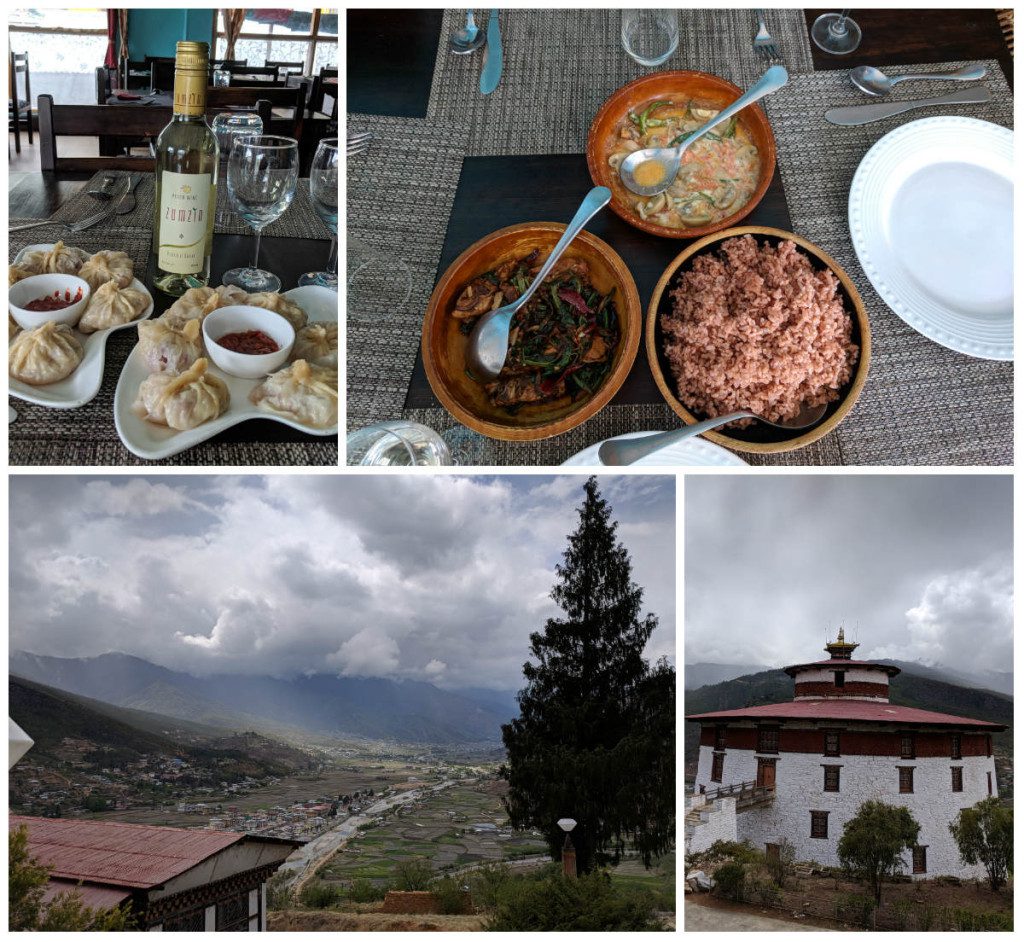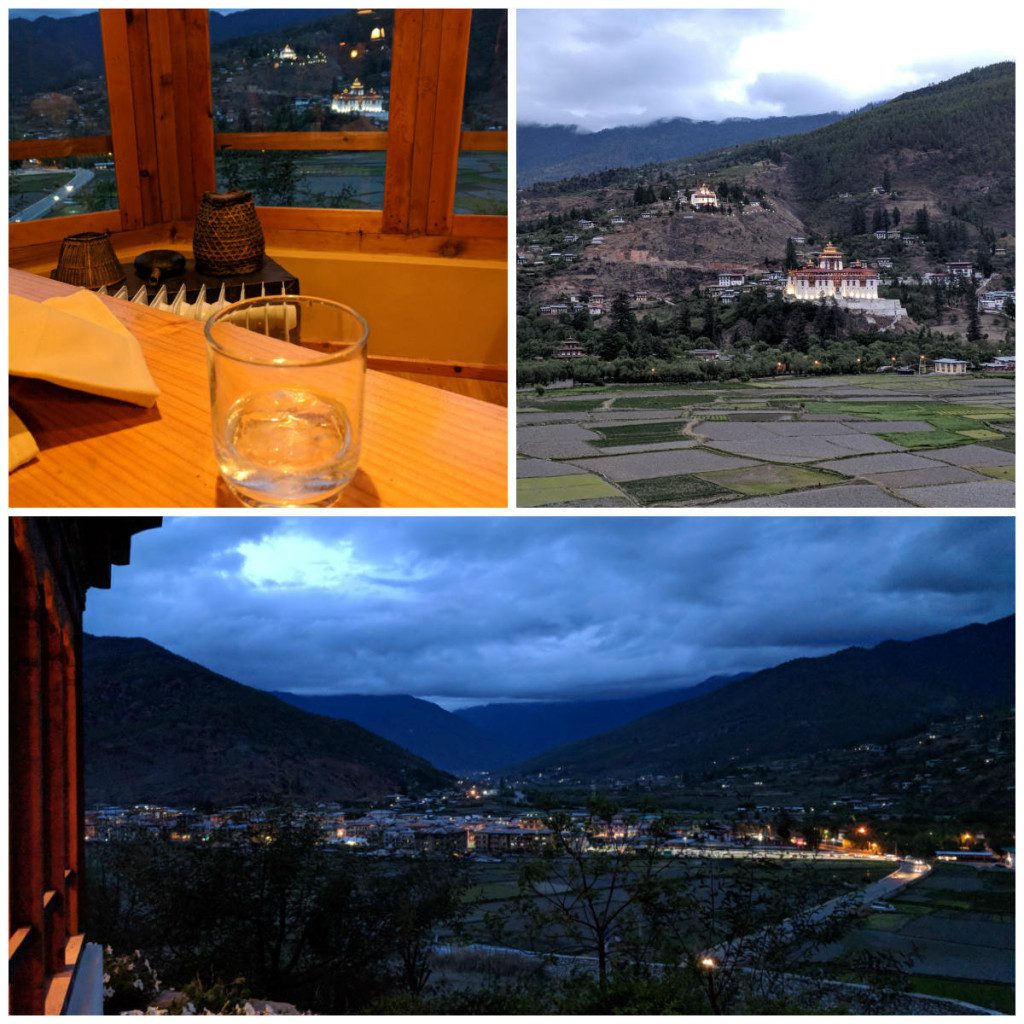Continued from Thimphu and Punakha
Part 3: Paro
After a breakfast that included a masala omelette and an aloo paratha, we set off for Paro. While on the latter dish and food in general, from what I understand folks in Bhutan don’t really like roti. They’re pretty happy to eat rice all day, happily acknowledging their tummy growth while at it. In many restaurants, rotis are for Indian tourists. Also, Buddha and non veg co-exist in Bhutan, and apparently the king is a non-vegetarian too. But then again, as per Theravada, the Buddha had no qualms about followers eating pork, chicken etc so long as the animal wasn’t killed specifically for them. In fact, they couldn’t refuse it if offered as alms since it would arouse the thought of ‘self’.
Meanwhile, the journey to Paro was the same route from the day before, barely bypassing Thimphu city. That made the journey almost a 2 hour one. We passed the airport, which we realised was a reasonably risky one to land at, given the proximity of the buildings. The Paro dzong was on the outskirts of the town and Sonam assured us that our hotel would give us a great view.
Lunch was once again a place Sonam and we agreed on – My Kind of Place. A contemporary cafe that had gotten rave reviews online. Comfortable and stylish seating and a nice view of the main road below. Here’s the thing – this would be an expected standard in say, Bangalore, but not so common in Bhutan. In that sense, we felt that Paro was more creature-comfort friendly than Thimphu.
Unfortunately, they didn’t have Hoentay (momo) that day, so we tried the noodle soup. Beef for me, and chicken for D. Pho like, both were excellent. Their Suja (butter tea) was also the best I had tasted thus far. We got the place to ourselves until the end when a party of moms and kids landed. From their behaviour, we stereotyped them as local posh moms, but they talked about paying in dollars that took that hypothesis for a spin!

After lunch, Sonam took us to Heavenly Bhutan’s own home stay – a 5 minute drive from town. They had their own little archery practice set up and D and I had a lot of fun trying to hit targets while dressed in local wear! We finally decided to check in at our hotel. Gangtey Palace was also T’s recommendation, and once again a very good one! It used to be the residence of royalty and senior administrators until getting converted into a hotel. Its construction is thus traditional, including a central tower which houses plenty of artifacts.

As Sonam had promised, it had a phenomenally good view of the Paro valley including the dzong. They had benches set up in the garden just for this. In fact, we also had a partial view from the small study in our room.

We rested until about 5PM, when Sonam picked us up for shopping and dinner. Paro’s main street is full of handicrafts and souvenir stores. This is the only place you need to do your shopping at. I had a minor adventure of almost breaking something at a store, but everything and everyone survived.
Dinner had been arranged at a farmhouse. D had expected the real deal, but this was the kind of “authentic” experience that’s custom made for tourists. It works, as we could hear exclamations of delight from the other rooms. The dinner was made interesting by the fact that our host, a local, had spent a few years in Bangalore. First as an engineering student in Kalyan Nagar, and then working in a BPO in Electronic City. She came back because her mom wanted her to handle this set up. I am reasonably sure it’s more lucrative. We discussed traffic, and how Bangalore had changed. On the way back, we picked up desserts from a shop in town. Bhutan doesn’t really have a thing for desserts.
Later D and I talked about how long Bhutan’s happiness goals could be sustained, specifically since tourists and the internet would result in a sharp increase in stimuli, thereby increasing wants and desires. We wondered about how our dinner host was coping. She actually seemed pretty happy and we discussed how a place’ culture could have a hand in it. Maybe culture influences one’s understanding of needs, acknowledgement of wants and the path thereon.
The next day was planned to be an early start, and Sonam had arranged with the hotel to give us breakfast at 6.30 so we could start at 7. We kept checking the hotel’s cafe and bar, and the reception, but couldn’t find anyone around. I finally found someone and figured out that the restaurant was actually separate, and not part of the cafe! We managed to leave 15 minutes later for the money shot of the trip – Tiger’s Nest.
It sits 900 m above Paro’s altitude of 2200 m, and is a 5 km (one way) hike away. The hike begins at a place about 30 minutes drive from Paro. There is a provision for horses for half of the trip, but we skipped. Sonam wanted to start early to avoid the crowds, including the horses which mush up the path. If you have been doing some level of exercise, this should be a good stretch for you, not really a stress. From the base, the climb does look impossible, but if you persist for the first couple of kilometres, which I reckon are the hardest and least structured, you should be fine. The second half has steps which ease up life a little bit. In any case, there are phenomenally good views all along the way. Thankfully, the weather was perfect and we reached the place in just less than 2 hours. It did get cold at the top though. The tour of the place took about half an hour. FYI, there’s no tiger, the nest is debatable. 😀 I noticed a lot of similarity between the deity and Shiva in Hindu mythology. The return journey obviously took lesser time – about half an hour less to be exact.

We were on time for an early lunch. Sonam had promised us Hoentays, he made the call on the way to ask for beef and pork. Lunch was at Lotus Bistro, and in addition to the momos, we had a mushroom ema datshi, a spicy chicken fry and red rice. All washed down with the favourite Zumzin. We then did our bulk Zumzin purchase for home, before going to the National Museum. The original version is being renovated and the displays are temporarily in a new building adjacent to it. In addition to the Buddhist religion’s history in the region, masks, flora and fauna, we also realised from the maps how China has been eating up the northern part of Bhutan. Just what they attempted with Arunachal Pradesh too, but completed successfully in Bhutan, because its government does not want a confrontation. The view from the National Museum is splendid, but there was another place we wanted to enjoy the view from.

That was the restaurant at Gangtey Palace. We were impressed by the view at breakfast, but were in a hurry. So we went over at 6.30PM to enjoy the view and peach brandy. The latter wasn’t available so we shifted to apple brandy which was just ok. The view though, was fantastic, and after dinner, we sat on the bench overlooking the valley before going back to the room.

The return trip next day should have been uneventful except it wasn’t. After a more leisurely breakfast, Sonam dropped us off at the airport. At the Druk Air checkin counter at Paro airport, we were told that currency exchange could be done only at the Arrival lounge, but we could do it after immigration. Clearly not the case. We checked the money we had, felt it wasn’t worth the hassle and decided to try our luck in Kolkata. That’s when I decided to window shop at the tiny Duty Free shop, and found some excellent Japanese wine for cheap! We decided to “save” our Bhutan currency by buying that!
At Kolkata airport, they decided not to let our two bottles through, despite the Duty Free packing and the receipt. No amount of reasoning helped. Their suggestion was to drink it or dump it. Since both were stupid suggestions, I decided to implement my kind of stupid. We bought a bag, and sent it via check in.
And that’s how we got an adventurous end to our peaceful journey. It was a wonderful trip with practically no problems. What helped was Heavenly Bhutan‘s perfect arrangements and their commitment to making it a pleasant experience for us.
Cost: We spent about 1.5L including the Kolkata stay, alcohol and other purchases including that damn bag in the end! At least 25% can be saved if you skip some of that and don’t insist on specific hotels.
